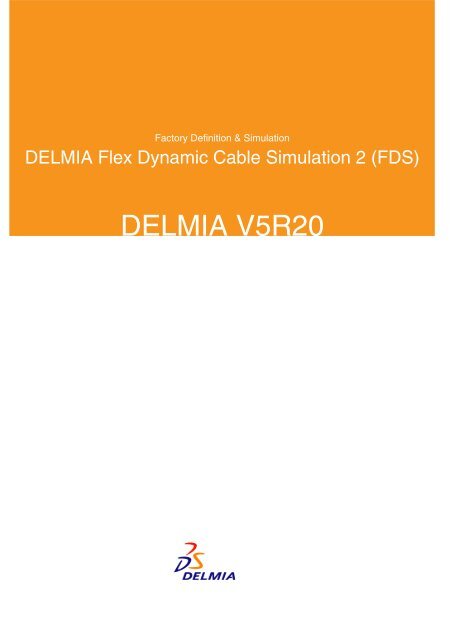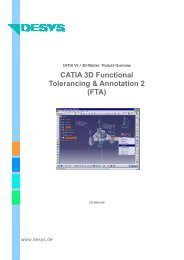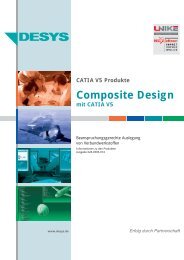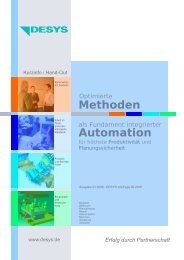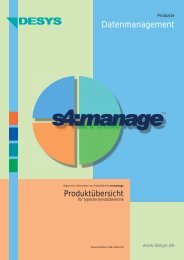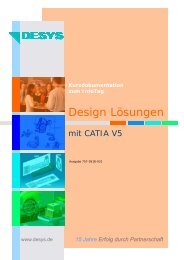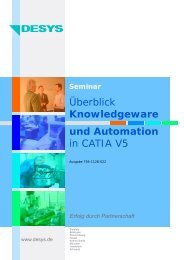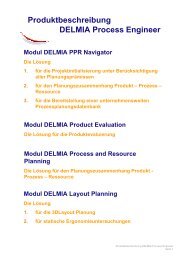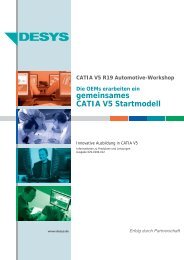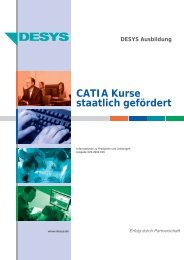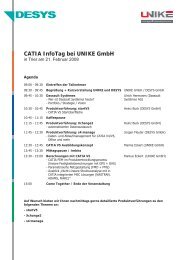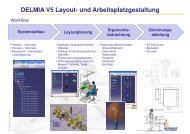DELMIA Flex Dynamic Cable Simulation 2 (FDS) - DESYS
DELMIA Flex Dynamic Cable Simulation 2 (FDS) - DESYS
DELMIA Flex Dynamic Cable Simulation 2 (FDS) - DESYS
You also want an ePaper? Increase the reach of your titles
YUMPU automatically turns print PDFs into web optimized ePapers that Google loves.
Factory Definition & <strong>Simulation</strong><br />
<strong>DELMIA</strong> <strong>Flex</strong> <strong>Dynamic</strong> <strong>Cable</strong> <strong>Simulation</strong> 2 (<strong>FDS</strong>)<br />
<strong>DELMIA</strong> V5R20
Factory Definition & <strong>Simulation</strong><br />
<strong>DELMIA</strong> <strong>Flex</strong> <strong>Dynamic</strong> <strong>Cable</strong> <strong>Simulation</strong><br />
Enhances user productivity by providing realistic behavior of cables<br />
including penetration avoidance for interactive simulation in<br />
manufacturing applications<br />
Product overview<br />
<strong>DELMIA</strong> <strong>Flex</strong> <strong>Dynamic</strong> <strong>Cable</strong> <strong>Simulation</strong><br />
provides a highly accurate, physically correct<br />
numerical simulation of flexible cables and<br />
hoses with circular cross-section for real-time<br />
interaction applications. Non-uniform material<br />
composition is supported including multi<br />
core, shielded or isolated cables; braided or<br />
multi layered hoses. Collision detection and<br />
contact simulation are enabled, reproducing<br />
complex nonlinear behavior of cables/hoses<br />
in contact with arbitrary shaped rigid<br />
geometry. Arbitrary connections of cables<br />
between each other and with rigid geometry<br />
are supported. As a result, wiring harnesses<br />
with multiple branches can be modeled and<br />
tested in real time, allowing for digital<br />
mock-ups and enhanced product design.<br />
<strong>Cable</strong>s, wires and hoses play an essential role<br />
in the assembly of any industry product. To<br />
consider physical cable properties in the<br />
digital design phase of a product helps<br />
detecting design problems such as those<br />
caused by collisions with rigid parts and other<br />
compliant parts. It also helps to determine<br />
production requirements, such as cable<br />
length and the respectively allowed tolerance.<br />
This realistic flexible cable analysis<br />
significantly reduces the costs for real-life<br />
mock-ups.<br />
The behavior of a flexible object is described<br />
by the theory of elasticity in terms of several<br />
material constants, i.e. Young's module and<br />
Poisson's ratio; or Lame coefficients or<br />
Bending and torsional stiffness etc. These<br />
material properties are related to each other<br />
by equivalence formulae. In the case of<br />
composite structures, e.g. multilayered<br />
cables/hoses corresponding effective<br />
constants can be either measured directly in<br />
experiments or computed using an additive<br />
formulae. Additionally required quantities are<br />
the length, external and internal diameters of<br />
the cable/hose/layer, volumetric mass<br />
density, as well as positions and orientations<br />
of the ends of the cable/hose. The theory of<br />
elasticity provides equations describing static<br />
and dynamical behavior of the flexible object<br />
under user interaction. Also various<br />
approximate models are known valid in<br />
special restricted situations.<br />
The robustness of the implemented scheme<br />
has been shown for a variety of realistic<br />
situations in interactive design environments.<br />
To guarantee the accuracy, the cables, wiring<br />
harnesses and hoses have been evaluated<br />
intensively. The results of the experimental<br />
validations show that shapes of wiring<br />
harnesses and hoses computed by <strong>DELMIA</strong><br />
<strong>Flex</strong> <strong>Dynamic</strong> <strong>Cable</strong> <strong>Simulation</strong> for Realistic<br />
<strong>Cable</strong> <strong>Simulation</strong> coincide at high accuracy<br />
with experimentally measured shapes.<br />
<strong>DELMIA</strong> <strong>Flex</strong> <strong>Dynamic</strong> <strong>Cable</strong> <strong>Simulation</strong><br />
solves exact non-linear elastic equations at<br />
machine precision, therefore the deviation<br />
between <strong>DELMIA</strong> <strong>Dynamic</strong> <strong>Cable</strong> <strong>Simulation</strong><br />
results and experiment was always on the<br />
level of 1% (since the experiments have been<br />
carried out with a 1% error). <strong>DELMIA</strong> <strong>Flex</strong><br />
<strong>Dynamic</strong> <strong>Cable</strong> <strong>Simulation</strong> is able to provide<br />
solution for simulation of cables and hoses<br />
combining physical precision and update rate<br />
Copyright © 2002-2008 Dassault Systemes - All rights reserved<br />
2
more than 80 fps on a P4 2GHz PC.<br />
Product Highlights<br />
<strong>DELMIA</strong> <strong>Flex</strong> <strong>Dynamic</strong> <strong>Cable</strong> <strong>Simulation</strong> offers<br />
the following functions:<br />
Provides physically realistic cable<br />
simulation<br />
Supports penetration avoidance<br />
between cable and obstacles<br />
Integrated with the <strong>DELMIA</strong> Device<br />
Task Definition product for Robotic<br />
applications.<br />
Supports interactive jogging motion as<br />
well as task program simulation<br />
Fully compatible with cable models<br />
created in CATIA design applications<br />
Product Key Customer Benefits<br />
Provides physically realistic cable<br />
simulation...<br />
The simulation includes the cable<br />
properties of length, diameter, density,<br />
stiffness and other constraints such as<br />
gravity and end clamp locations.<br />
Supports penetration avoidance between<br />
cable and obstacles...<br />
The simulation can be setup by the user to<br />
specify the objects that the cable may not<br />
penetrate. Once this is done, the solver<br />
automatically accounts for the cable shape<br />
that corresponds to the realistic behaviors<br />
during simulation.<br />
Integrated with the <strong>DELMIA</strong> Device Task<br />
Definition product for Robotic<br />
With <strong>DELMIA</strong> <strong>Flex</strong> <strong>Dynamic</strong> <strong>Cable</strong><br />
<strong>Simulation</strong> installed and enabled, the<br />
<strong>DELMIA</strong> Device Task Definition application<br />
provides an additional toolbar for<br />
simulation of cables that are defined for<br />
dress up of Robots and other<br />
manufacturing resources for validation of<br />
cable length, interference and wrapping<br />
behaviors during robotic applications.<br />
Supports interactive Jogging motion as<br />
well as Task program simulation...<br />
The physically realistic behavior of the<br />
cables is automatically enabled during<br />
interactive motion by users of the cable<br />
ends or obstacles as well as during the<br />
running of preprogrammed Task<br />
simulations.<br />
Fully compatible with cable models<br />
created in CATIA design applications...<br />
<strong>Cable</strong>s designed in CATIA applications<br />
such as CATIA Electrical Harness<br />
Installation are the starting point for<br />
<strong>DELMIA</strong> simulations based on the<br />
designed cable positions, lengths,<br />
diameters, and branches.<br />
Copyright © 2002-2008 Dassault Systemes - All rights reserved<br />
3
ABOUT <strong>DELMIA</strong> V5R20<br />
<strong>DELMIA</strong> enables companies to develop and anticipate optimal process for their manufacturing needs.<br />
www.3ds.com/products/delmia<br />
For more information about our products visit www.3ds.com/contact<br />
Copyright © 2002-2008 Dassault Systemes - All rights reserved


